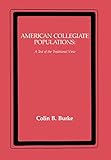American Collegiate Populations : A Test of the Traditional View / Colin Burke.
Material type: TextPublisher: New York, NY : New York University Press, [2020]Copyright date: ©1982Description: 1 online resourceContent type:
TextPublisher: New York, NY : New York University Press, [2020]Copyright date: ©1982Description: 1 online resourceContent type: - 9780814710388
- 9780814725054
- 378.73 19/eng/20230216
- LA226 .B85 1982
- online - DeGruyter
| Item type | Current library | Call number | URL | Status | Notes | Barcode | |
|---|---|---|---|---|---|---|---|
 eBook
eBook
|
Biblioteca "Angelicum" Pont. Univ. S.Tommaso d'Aquino Nuvola online | online - DeGruyter (Browse shelf(Opens below)) | Online access | Not for loan (Accesso limitato) | Accesso per gli utenti autorizzati / Access for authorized users | (dgr)9780814725054 |
Frontmatter -- Contents -- Introduction. The Traditional View -- Chapter 1. The Institutions -- Chapter 2. Enrollments -- Chapter 3. Student Backgrounds -- Chapter 4. Student Careers -- Chapter 5. The Colleges in Perspective -- Notes -- Appendix A. Institutions in Operation, 1800-1860 -- Appendix B. NonCollegiate Institutions -- Index
restricted access online access with authorization star
http://purl.org/coar/access_right/c_16ec
American Collegiate Populations is an exhaustive and definitive study of the membership of American colleges and universities in the nineteenth century. Colin B. Burke explores the questions of who went, who stayed and where they came from, presenting as answers to these questions a mass of new data put together in an original and interpretive manner.The author offers a devastating critique of the two reference works which until now have commanded scholars' attention. Burke examines Bailey Burritt's Professional Distribution of College and University Undergraduates (1912) noting that Burritt's categories oversimplify the data of the 37 institutions he studies. Donald G. Tewksbury's American Colleges and Universities Before the Civil War (1932), the author explains, presents a skewed interpretation of collegiate decline in the antebellum period. Using a far larger data base and capitalizing on the advances in quantitative history made in the last decade, Burke adopts appropriate analytic categories for college students and their subsequent careers. Amierican Collegiate Populations thus becomes the referent work to replace Burritt and Tewksbury and will likely have an equal longevity in print.American Collegiate Populations systematically compares denominational colleges, colleges by region, and student groups from a host of angles - age entering college, geographical origins, parental occupations. subsequent careers, and professional choices. Burke shows the reach of American colleges back into the socio-economic fabric of the culture. a reach that carries implications for many subjects - religious, economic, social, and intellectual - beyond the mere subject of college alone.Few works force the re-thinking of a whole field of historical inquiry - particularly one that has important bearings on current policy - as Burke's study does. The findings and implications presented in American Collegiate Populations will profoundly affect the scholarly community for decades to come.
Mode of access: Internet via World Wide Web.
In English.
Description based on online resource; title from PDF title page (publisher's Web site, viewed 06. Mrz 2024)


